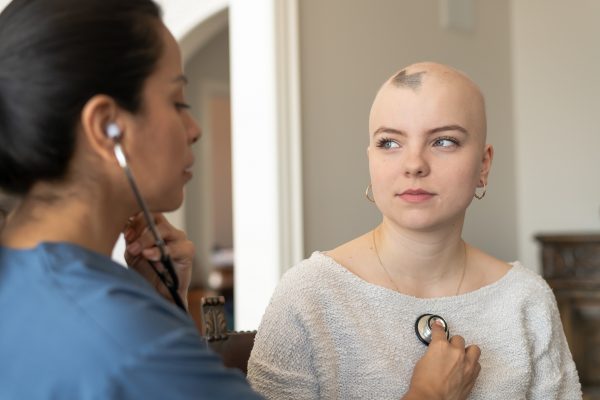
The need for allogeneic haematopoietic stem cell transplantation (allo-HSCT) in adults with Philadelphia chromosome-negative (Ph-neg) acute lymphoblastic leukaemia (ALL) with high-risk features and adequate measurable residual disease (MRD) clearance remains unclear. Therefore, the ALL-HR-11 trial aimed to evaluate the outcomes of these patients following chemotherapy or allo-HSCT. For patients with a good MRD clearance after induction and early consolidation, promising outcomes without allo-HSCT were obtained.
Even in 2021 there remains to be a discussion on whether or not an allogeneic stem cell transplantation (allo-SCT) in patients with high-risk Ph-negative ALL is superior to chemotherapy. Recently, Ribera et al. did a novel attempt to answer this question. This was a large prospective study in almost 350 adolescent and adult patients with high-risk Philadelphia negative ALL of which 220 patients achieved MRD <0.1% after induction therapy. In total, 218 patients were treated with polychemotherapy and 106 patients underwent an allo-SCT. The overall survival and event-free survival were not inferior for patients who did not receive a transplant, compared to patients who did receive a transplantation (respectively 45% and 59% versus 40% and 38%), on the condition that an adequate MRD response was obtained. The authors therefore conclude that better post-remission interventions are needed for patients with inferior MRD results.
To date, treatment of Ph-neg ALL in adults is still based on conventional multidrug chemotherapy, potentially followed by allogeneic hematopoietic stem cell transplantation (allo-HSCT).1,2 The decision to opt for a transplant in all Ph-neg ALL patients with high-risk (HR) features is still subject of debate and has been addressed in several prospective protocols.3 In the PETHEMA ALL-AR-03 study, sparing allo-HSCT in these patients was associated with promising results. However, this trial included patients with less stringent high-risk features than what is usually employed to define high-risk ALL, and combined morphologic and measurable residual disease (MRD) studies were used for evaluation of response and treatment assignment.4
The ALL-HR-11 trial included 348 adolescents and adults between 15-60 years old with Ph-neg ALL and high-risk features. High-risk ALL was defined based on at least one of the following criteria: age between 30 and 60 years, white blood cell (WBC) count >30×109/L for B-cell precursor (BCP)-ALL or >100×109/L for thymic T-ALL, pro-B-ALL, early T-ALL or mature T-ALL, hypodiploid ALL, ALL with t(v;11q23) or KMT2A rearrangements or with complex karyotype (≥5 unrelated clonal abnormalities). Patients in complete response (CR) and MRD levels (centrally assessed by 8-color flow cytometry) <0.1% after induction and <0.01% after early consolidation were assigned to receive delayed consolidation and maintenance therapy for up to two years in CR. The remaining patients were allocated to allo-HSCT. By intention-to treat, 218 patients were assigned to chemotherapy and 106 to allo-HSCT.5
A complete response was obtained in 289 patients (83%) with 220 patients with an MRD < 0.1%. MRD response < 0.01% after Induction-1 was obtained in 63% of patients achieving CR with available MRD assessment. Induction-2 was administered to 99 patients (41 after failure of Induction-1 and 58 in CR but MRD ≥0.1%).
The five-year (±95%CI) cumulative incidence of relapse (CIR), overall survival (OS) and event-free survival (EFS) probabilities for the whole series were 43%±7%, 49%±7% and 40±6%, respectively. Relapse occurred in 74/218 patients assigned to chemotherapy and in 29/90 cases assigned to allo-HSCT, with a five-year CIR of 45%±8% and 40%±12%, respectively. The five-year OS probabilities were 59%±9% and 38%±11%, respectively. The five-year OS probability of the 48 patients who showed MRD <0.01% on day 14 of induction was 82% (69%-95%), which is significantly better than what was seen in patients with an MRD level of 0.01%-<0.1% or those with MRD ≥0.1%.5
This analysis showed that patients with good early MRD response to induction therapy and complete MRD response after early consolidation treatment have promising outcomes with paediatric-inspired chemotherapy without allo-HSCT. Better post-remission alternative therapies are especially needed for patients with poor MRD clearance.
References